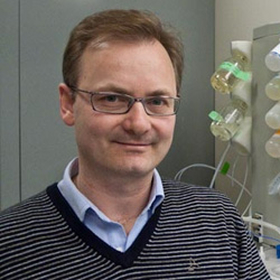

312 Church St. SE
Minneapolis, MN 55455
United States
Gianluigi
Veglia
The Veglia lab focuses on two critical aspects of cell regulation: cAMP-mediated cell signaling and calcium transport. These events are orchestrated by soluble and membrane-bound protein complexes. To characterize their structure, dynamics, and interactions, we utilize a multidisciplinary approach combining solution and solid-state NMR spectroscopy with other biophysical methods. Our goal is to understand how these protein complexes mediate allosteric signal transduction in cells and how pathological mutations of these proteins are linked to diseases.
Research interests
Cyclic AMP (cAMP)-mediated cell signaling and calcium transport.
A primary cAMP receptor is the cAMP-dependent protein kinase A (PKA). This enzyme was the first kinase to be crystallized and has been used as the prototypical example for the AGC protein kinase family. In the inactive form, PKA adopts a homotetrameric assembly (holoenzyme) with two catalytic subunits (C subunits or PKA-C) and two regulatory subunits (R subunits). The holoenzyme is anchored to the membrane via A-kinase anchoring protein (AKAP). The classical activation mechanism involves cAMP binding to the R subunits and the release of PKA-C, which is free to phosphorylate a plethora of substrates. While several aberrant mutations have been discovered in the R subunit, in the past decades, mutations, deletions, and fusions have been found in the PRKACA gene encoding for PKA-C. These modifications are responsible for dysregulating cAMP signaling and the progression of diseases such as Cushing’s syndrome, myxomas, and fibrolamellar hepatocellular carcinomas. Our group utilizes spectroscopic and biophysical methods to understand how these mutations perturb the structural dynamics and allosteric signaling of PKA-C, resulting in dysfunctional cAMP signaling and leading to disease.
Calcium transport in the sarcoplasmic reticulum
Calcium transport is central to cardiac and skeletal muscle contractility. Its homeostatic balance is modulated by the sarcoplasmic reticulum Ca2+-ATPase (SERCA), which handles ~70% of intracellular Ca2+ regulation in humans. SERCA is an integral membrane protein whose function is regulated by an array of single-pass membrane proteins called regulins. Regulins keep this ATPase’s activity within a narrow physiological window. Dysregulation of SERCA activity degenerates into muscle disease. So far, seven regulins have been sequenced: phospholamban (PLN), sarcolipin (SLN), endoregulin (ELN), another regulin (ALN), myoregulin (MLN), dwarf open reading frame (DWORF), and sarcolamban (SCL, Drosophila m.). These regulins are single-pass membrane proteins that bind SERCA in the transmembrane domain and allosterically control SERCA’s apparent affinity for Ca2+ ions. Some regulins are post-translationally modified (e.g., phosphorylated, lipidation, acetylation, etc.). These events reverse or augment regulins’ regulatory function. In the past decade, it was found that SERCA’s regulatome has a new player, HAX-1, an intrinsically disordered protein that interacts with the other regulins to enhance their function. We aim to understand how regulins and HAX-1 interact with SERCA to augment or decrease Ca2+ transport and concomitant muscle contractility. Understanding the molecular determinant for Ca2+ transport by SERCA is critical to devise new and innovative therapy to counteract muscle disease, including heart failure.
Selected publications
cAMP-signaling
Calcium signaling
Education
M.S. in Chemistry, University of Rome ‘La Sapienza’, Rome - Italy (1991)
Ph.D. in Chemistry, University of Rome ‘La Sapienza’, Rome - Italy (1994)
Visiting Scholar, SUNY Stonybrook, NY – USA (1994)
Noopolis Postdoctoral Fellow, University of Pennsylvania, Philadelphia - USA (1995 - 2000)